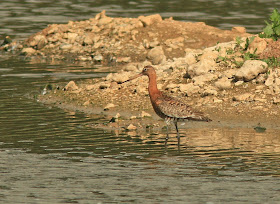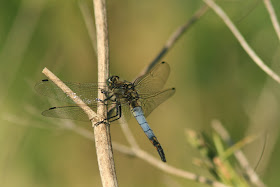
BREEDING BIRDS
Most species have raised their young by August. Tufted Ducks are one of the latest breeding birds with the young appearing in late July/early August. Several species including Mallard, Moorhen and Coot have several broods. The breeding summer warblers and tits start to gather in flocks from mid July on. In recent years juvenile Peregrines are a feature.

MIGRANTS
Green Sandpipers are one of the first returning migrants (from late June). In July numbers increase and they are joined by smaller numbers of Common Sandpiper. Lawpings start to form flocks from mid July onwards. Little Ringed Plovers are features of July with family parties often staging at the farm.
July is the best month for the locally rare Black-tailed Godwit. From late July onwards there is also a chance of seeing migrating Whimbrel and terns. Wood Sandpiper may also occur.
 Several pulses of passerine migrants pass through during the early autumn. Presumably the first pulses involve locally breeding birds and the arrival of groups of warblers and migrants in August are presumably new groups of birds from further afield. Mixed warbler/ tit flocks are characteristic with Blackcap, Whitethroat, Lesser Whitethroat, Chiffchaff, Willow Warbler, Lesser Whitethroat and sometimes Garden Warbler. Cuckoo is a bird associated with early autumn. Wheatear and Whinchat are associated more with August onwards and a Spotted Flycatcher or Redstart
Several pulses of passerine migrants pass through during the early autumn. Presumably the first pulses involve locally breeding birds and the arrival of groups of warblers and migrants in August are presumably new groups of birds from further afield. Mixed warbler/ tit flocks are characteristic with Blackcap, Whitethroat, Lesser Whitethroat, Chiffchaff, Willow Warbler, Lesser Whitethroat and sometimes Garden Warbler. Cuckoo is a bird associated with early autumn. Wheatear and Whinchat are associated more with August onwards and a Spotted Flycatcher or Redstartwould be a real treat.


Set against the backdrop of the normal patterns described is the chance of a weather related influx (a fall or flight). North-east to east winds with associated frontal conditions can produce major disruptions to normal patterns and invoke an influx of deflected migrants with are both pushed overland and westwards by the wind and then forced to reduce altitude by low cloud cover/ rain. The normal migration pattern for these birds would involve a combination of a more eastward route and/or a much higher flight altitude. A light to moderate easterly airflow is the most conducive (the weather chart shows conditions on August 10th 1999 which produced 3 Knot and 7 Wood Sandpipers amongst a host of other waders). When wind speed and rain is too intense it appears that migration stops altogether. A good time to witness a significant 'fall' is just before the weather becomes intolerable.
To a lesser degree showers on prevailing winds can also produce falls with birds in effect being flushed down from higher altitude.
FEEL FREE TO JOIN THE BEDDINGTON FARMLANDS EARLY AUTUMN BIRD TOUR ON SUNDAY AUGUST 8TH LED BY MYSELF. MEET UP AT 0915-0930 AT HACKBRIDGE TRAIN STATION. TOUR TO LAST 1.5- 2 HOURS. ALL ARE WELCOME.







































